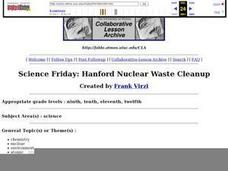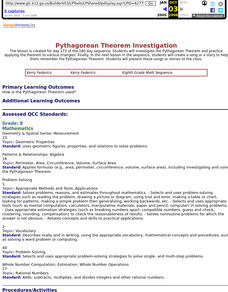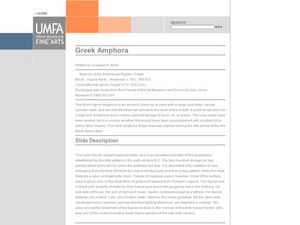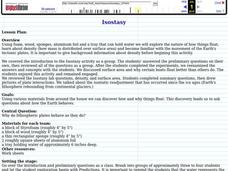Curated OER
Intro to Civil Engineering and Hydrology
Students identify the processes involved in the water cycle. In this math lesson, students explain what civil engineers and hydrologist do. They watch a video about flooding in Texas.
Curated OER
Adorable Snow Folks
Students create "Snow Folks" using children's mittens, rice, wooden balls, and various art materials in this Art instructional activity for grades Four and up. The instructional activity includes picture examples and suggestions for...
Curated OER
World Map and Globe
Students explore symbols. In this beginning map instructional activity, students identify common picture symbols. Students place post-it notes with symbols drawn on them in the appropriate place on a map.
Curated OER
Map on the Wall
Learners examine the Ogallala aquifer water storage facility, identify rivers that refill the aquifer, and locate major cities near by. Students make maps of the area.
Curated OER
Science Friday: Hanford Nuclear Waste Cleanup
Students practice careful listening skills to learn about problems regarding cleanup of radioactive wastes at the Hanford nuclear reservation in Washington State. Students answer the questions imbedded in the lesson as they listen to the...
Curated OER
Where Does Water Run Off After School?
Students conduct a study of the school grounds in order to find information about how water moves during the rainy season. They estimate the area of the school grounds and determine the route that water would take as storm runoff.
Curated OER
Planting A Garden On Campus
Students investigate the school campus area in order to plan the best spot for a class garden. They create a map of the school and research the different types of soil that exist in order to find the best spot. The class takes the...
Curated OER
Biomes and Plant Growth
Seventh graders design four biomes models and plant three types of seeds in them to observe growth. In groups for each type of biome, they predict the seeds' growth in each of the settings. Students follow the conditions on a biome chart...
Curated OER
Around the Clock
Middle schoolers discover the relationship between the circumference of a circle and its diameter. They find the length of an arc of a circle.Students use estimation strategies in real-world applications to predict results (i.e.,...
Curated OER
Friction- What a Drag
Students explore friction. In this friction lesson, students investigate that weight and surface type affect friction.
Curated OER
Pythagorean Theorem Investigation
Eighth graders investigate the Pythagorean Theorem and practice applying the theorem to various triangles. Finally, in the next lesson in the sequence, 8th graders create a song or a story to help them remember the Pythagorean Theorem.
Curated OER
Tasty Solution
Students examine the difference between a solvent, solute and solution. In this solutions lesson students complete an experiment and observe what happens when a solution is stirred.
Curated OER
Physics at the Zoo
Students visit a local zoo and answer physics questions that are a part of zoo life. In this zoo physics lesson students answer questions that have to do with the physics of animal size, their center of gravity and how animals travel.
Curated OER
Water and Land 207
Students examine maps of different projections, mathematically calculate distortions, and note the advantages and disadvantages of each map. They study the different maps and transfer the map to graph paper.
Curated OER
Greek Amphora
Students analyze the Greek Amphora figure in Greek art and complete related activities. In this Greek art activity, students analyze the Greek vase art and the Antimenes painter style. Students research mythology sections for stories of...
Curated OER
Volumes of Solids of Revolution (Shell Method)
Students find the volume of solids and disks. In this finding the volume of solids and disks lesson, students find the volume using the washer, disk, and shell method. Students integrate functions in terms of x and y. Students use...
Curated OER
Identifying and Using Parallelism and Balance in Literature
Analyze the use of balanced sentences and parallelism in a narrative. Included in this resource is a narrative about serving as a Peace Corps volunteer in Kazakhstan titled, "The Train Ride Home". Middle and high schoolers review...
Curated OER
Motion in the Ocean
How does the formation of currents and waves in the ocean happen? High schoolers will learn about the primary causes for ocean currents and waves by calculating a wave's amplitude and nautical mile speed. Then they will complete a...
Curated OER
Water Works
Students create a "water web" to illustrate the interdependence among water users and producers. They distinguish between direct and indirect uses of water; illustrate the interconnectedness of water users in a community; and demonstrate...
Curated OER
Science: Lead Shot and Waterfowl
Students examine data to investigate the impact of lead shot pellets on waterfowl populations. They graph their findings and discover how lead in ingested by birds and poisons them. As an extension, students research legislation and...
Curated OER
Great Lakes Food Web
Students identify species and components of a Great Lakes food web. Using note cards, they place themselves in the correct order of the food chain based on the species present. They discuss what they believe happens to various species...
Curated OER
Poetry in Motion
Sixth graders answer questions about "From a Railway Carriage." They discuss different poetical forms. They work together to write a poem about travel.
Curated OER
Hierarchy Theory and Biotic Hierarchy
Learners examine the hierarchy theory and biotic organization by playing a teacher-created card game matching groups of items, such as organelles, in suits of four. They discuss the reasons for their hierarchical organization of the...
Curated OER
Measurement
Students create two prisms out of the same paper. They calcuate the number of centimeter cubes needed to fill each prism. They discover the concept of volume.

























